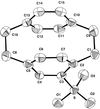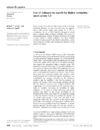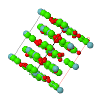issue contents
December 2001 issue

Cover illustration: The structure of Pu31Pt20 [D. T. Cromer & A. C. Larson (1977). Acta Cryst. B33, 2620-2627] viewed nearly perpendicular to a Pu, Pt disc (10 Å thick and 50 Å in diameter) down [111]. Details of the structure were taken from the intermetallics crystal structure database CRYSTMET® using the Materials ToolKit graphics software from Toth Information Systems, Inc.
research papers
The software program SPuDS has been developed to calculate the crystal structures of distorted perovskites. Calculated structures are compared with known crystal structures in order to verify the accuracy of this approach. Further calculations are presented to demonstrate the possible application of this program for synthesizing new materials.
The incommensurately modulated structure of the natural melilite (Ca1.89Sr0.01Na0.08K0.02)(Mg0.92Al0.08)(Si1.98Al0.02)O7 has been refined from single-crystal X-ray diffraction data. The refinement program Jana2000 has been modified to account for a severe overlap of satellite reflections m × n = ±1.
Download citation


Download citation


The investigation of the structural behaviour of Ba(OD)2 with varying temperature reveals a new low-temperature polymorph. The phase transition is caused by an order–disorder mechanism, since a D atom, which on average occupies a special position on a mirror plane, is frozen at a general position at low temperature.
Download citation


Download citation


As a small amount of lithium is inserted into the host material V6O13 two new superlattice structures Li2/3V6O13 and LiV6O13 are formed. The insertion of lithium causes the superlattice formation as well as a charge reduction of specific V atoms in the structure.
An algorithm using group theory has been developed that generates all of the nonequivalent closest-packed stacking sequences of length N.
Download citation


Download citation


Crystal structures of [Cu(hfac)2(pm)]n (pm = pyrimidine), [Cu(hfac)2(4-Me-pm)]n, [Cu(hfac)2(qz)]n (qz = quinazoline) and Cu3(hfac)6(4-Me-pm)2 were determined and relations between structures and magnetic interactions were discussed.
Download citation


Download citation


The direction of the rotation of the para-phenylene rings in sulfonated [2.2]paracyclophanes depends on the degree of sulfonation.
Download citation


Download citation


Two examples of phase transformations in cyanurates are compared. One of them describes single-crystal to polycrystalline transitions from stacking to herringbone packing modes. The other is a single-crystal to single-crystal phase transformation involved with a very small atomic displacement. The DSC thermographs, structures and thermal motion analysis are discussed.
With the help of software designed to detect cases of missed higher symmetry, we have searched the Cambridge Structural Database for entries in space group No. 5 and identified 50 cases in which the structure should be described in space groups of higher symmetry. The most common revision is to space group C2/m, which entails adding a center of inversion and usually results in important changes in bond lengths and angles.
Download citation


Download citation


The crystal and molecular structures of three β-ketosulfones have been investigated using X-ray analysis and density functional theory supplemented by ab initio Hartree–Fock calculations. At room temperature and in daylight the pale yellow, orthorhombic polymorph of the benzoylmethyl phenyl sulfone undergoes a transformation to a stable, colourless, monoclinic crystal form.
Hydrogen-bonding patterns in mono- and dialcohols are strongly correlated with steric effects. Empirical rules governing the packing of these compounds can be discerned, but they are not transferable to even closely related systems.
Download citation


Download citation


The synthesis, structure and non-linear optical properties of L-argininium hydrogen selenite hydrate are reported. It crystallizes in the non-centrosymmetric space group C2 with four formula units per cell. This compound shows a second-harmonic generation power about twice that of urea, as measured on polycrystalline samples by the Kurtz method.
Download citation


Download citation


The neutron diffraction study at 20 K on a single crystal of cyclodecaamylose·27.18H2O permitted the characterization of the hydrogen-bond network in the novel structural motifs band-flip and kink which occur in larger α-(1→4)-D-glucoside oligosaccharides with 10 or more glucoside units.
Download citation


Download citation


Amino acid complexes of glutaric acid and other dicarboxylic acids exhibit a variety of ionization states and stoichiometry. While some complexes contain already characterized aggregation patterns, new patterns are observed in others.
Statistical analyses of data retrieved from the Cambridge Structural Database, and density functional theory calculations on model molecules, are used to investigate the relative hydrogen-bond acceptor abilities of amino and cyano N atoms in N—T—C≡N (T is a transmitter of resonance effects) and N—(Csp2)3—C≡N molecular fragments. The nitrile nitrogen is almost always the preferred hydrogen-bond acceptor, since in push–pull systems the amino nitrogen lone pair is delocalized through the π system of the transmitter towards the nitrile nitrogen, whereas in aliphatic aminonitriles the amino nitrogen is shown to be sensitive to steric hindrance.
Squaric acid (SQ) is a strong diprotic acid that can crystallize as pure H2SQ, as well as hydrogen squarate (HSQ−) or squarate (SQ2−) anions interacting with a variety of hydrogen-bond donors. The HSQ− ions easily form a number of supramolecular architectures connected by strong O—H⋯O bonds. A rationalization of the observed structural motifs is attempted in terms of the formation of HSQ− polyanions and of their ability to pack with aromatic bases protonated by the dissociation of the squaric acid itself.


 journal menu
journal menu

































